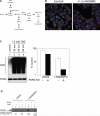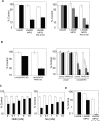Bioenergetic metabolites regulate base excision repair-dependent cell death in response to DNA damage
- PMID: 20068071
- PMCID: PMC2808464
- DOI: 10.1158/1541-7786.MCR-09-0411
Bioenergetic metabolites regulate base excision repair-dependent cell death in response to DNA damage
Abstract
Base excision repair (BER) protein expression is important for resistance to DNA damage-induced cytotoxicity. Conversely, BER imbalance [DNA polymerase beta (Polbeta) deficiency or repair inhibition] enhances cytotoxicity of radiation and chemotherapeutic DNA-damaging agents. Whereas inhibition of critical steps in the BER pathway result in the accumulation of cytotoxic DNA double-strand breaks, we report that DNA damage-induced cytotoxicity due to deficiency in the BER protein Polbeta triggers cell death dependent on poly(ADP-ribose) (PAR) polymerase activation yet independent of PAR-mediated apoptosis-inducing factor nuclear translocation or PAR glycohydrolase, suggesting that cytotoxicity is not from PAR or PAR catabolite signaling. Cell death is rescued by the NAD(+) metabolite beta-nicotinamide mononucleotide and is synergistic with inhibition of NAD(+) biosynthesis, showing that DNA damage-induced cytotoxicity mediated via BER inhibition is primarily dependent on cellular metabolite bioavailability. We offer a mechanistic justification for the elevated alkylation-induced cytotoxicity of Polbeta-deficient cells, suggesting a linkage between DNA repair, cell survival, and cellular bioenergetics.
Figures




Similar articles
-
Temporal dynamics of base excision/single-strand break repair protein complex assembly/disassembly are modulated by the PARP/NAD+/SIRT6 axis.Cell Rep. 2021 Nov 2;37(5):109917. doi: 10.1016/j.celrep.2021.109917. Cell Rep. 2021. PMID: 34731617 Free PMC article.
-
Preventing oxidation of cellular XRCC1 affects PARP-mediated DNA damage responses.DNA Repair (Amst). 2013 Sep;12(9):774-85. doi: 10.1016/j.dnarep.2013.06.004. Epub 2013 Jul 18. DNA Repair (Amst). 2013. PMID: 23871146 Free PMC article.
-
DNA polymerase β-dependent cell survival independent of XRCC1 expression.DNA Repair (Amst). 2015 Feb;26:23-9. doi: 10.1016/j.dnarep.2014.11.008. Epub 2014 Dec 3. DNA Repair (Amst). 2015. PMID: 25541391 Free PMC article.
-
Modulating poly (ADP-ribose) polymerase activity: potential for the prevention and therapy of pathogenic situations involving DNA damage and oxidative stress.Curr Pharm Biotechnol. 2002 Sep;3(3):275-83. doi: 10.2174/1389201023378265. Curr Pharm Biotechnol. 2002. PMID: 12164482 Review.
-
Poly(ADP-ribose) makes a date with death.Curr Opin Chem Biol. 2007 Dec;11(6):644-53. doi: 10.1016/j.cbpa.2007.08.038. Epub 2007 Oct 23. Curr Opin Chem Biol. 2007. PMID: 17936669 Review.
Cited by
-
A human liver microphysiology platform for investigating physiology, drug safety, and disease models.Exp Biol Med (Maywood). 2016 Jan;241(1):101-14. doi: 10.1177/1535370215592121. Epub 2015 Jul 22. Exp Biol Med (Maywood). 2016. PMID: 26202373 Free PMC article.
-
Enzyme mechanism-based, oxidative DNA-protein cross-links formed with DNA polymerase β in vivo.Proc Natl Acad Sci U S A. 2015 Jul 14;112(28):8602-7. doi: 10.1073/pnas.1501101112. Epub 2015 Jun 29. Proc Natl Acad Sci U S A. 2015. PMID: 26124145 Free PMC article.
-
Genome instability caused by a germline mutation in the human DNA repair gene POLB.PLoS Genet. 2012;8(11):e1003086. doi: 10.1371/journal.pgen.1003086. Epub 2012 Nov 8. PLoS Genet. 2012. PMID: 23144636 Free PMC article. No abstract available.
-
New strategies to maximize therapeutic opportunities for NAMPT inhibitors in oncology.Mol Cell Oncol. 2015 Jun 10;3(1):e1052180. doi: 10.1080/23723556.2015.1052180. eCollection 2016 Jan. Mol Cell Oncol. 2015. PMID: 27308565 Free PMC article. Review.
-
Increased PARP-1 association with DNA in alkylation damaged, PARP-inhibited mouse fibroblasts.Mol Cancer Res. 2012 Mar;10(3):360-8. doi: 10.1158/1541-7786.MCR-11-0477. Epub 2012 Jan 13. Mol Cancer Res. 2012. PMID: 22246237 Free PMC article.
References
-
- Ashworth A. A synthetic lethal therapeutic approach: poly(ADP) ribose polymerase inhibitors for the treatment of cancers deficient in DNA double-strand break repair. J Clin Oncol. 2008;26(22):3785–90. - PubMed
-
- Paik J, Duncan T, Lindahl T, Sedgwick B. Sensitization of human carcinoma cells to alkylating agents by small interfering RNA suppression of 3-alkyladenine-DNA glycosylase. Cancer Res. 2005;65(22):10472–7. - PubMed
Publication types
MeSH terms
Substances
Grants and funding
LinkOut - more resources
Full Text Sources
Other Literature Sources
Research Materials

